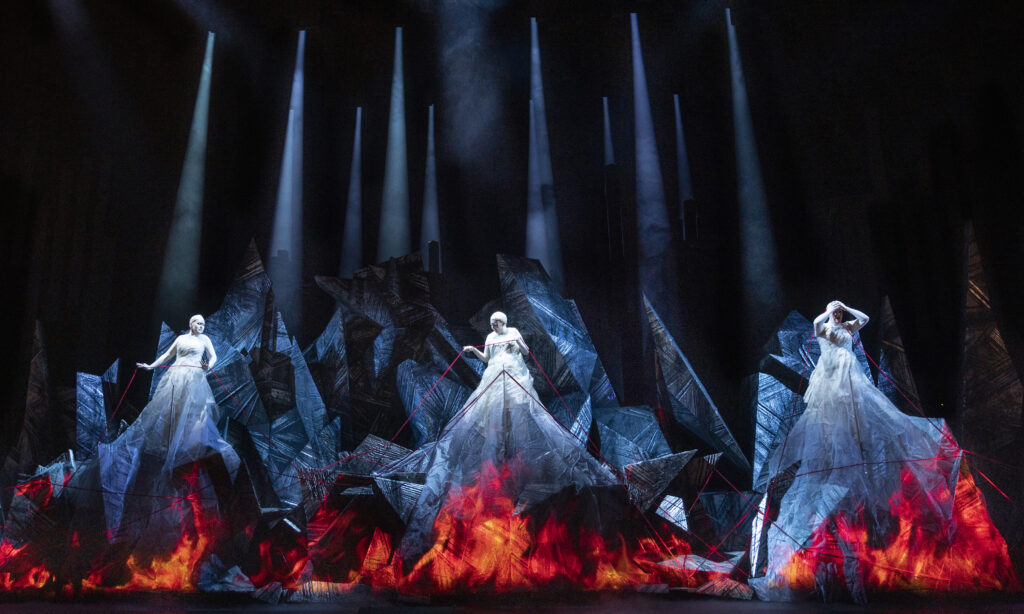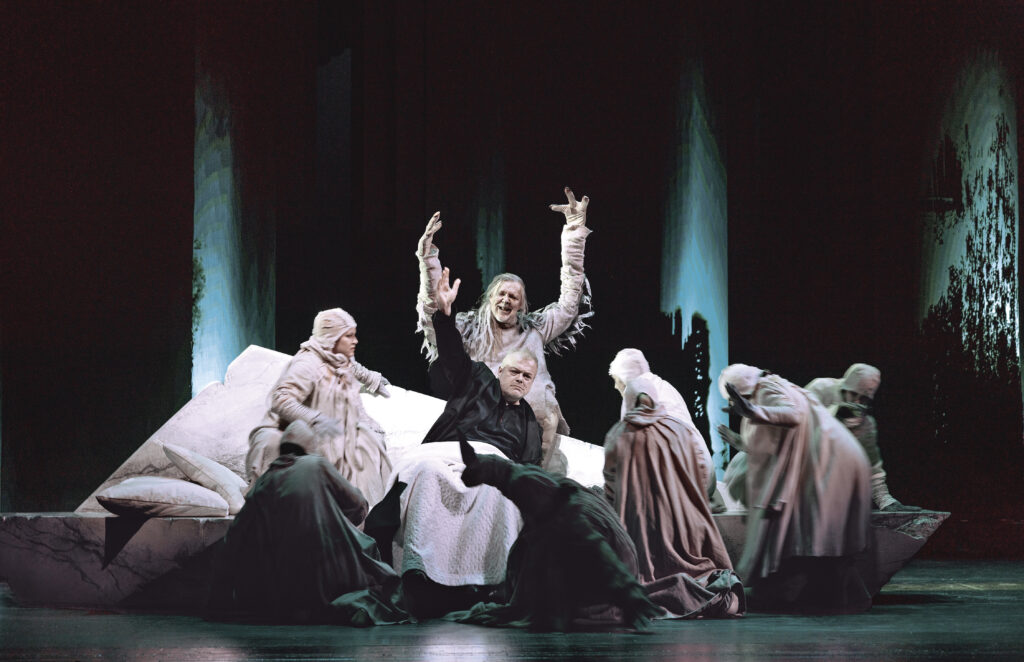‘Ring’-final in Helsinki: The Finnish National Opera concludes its new cycle production with ‘Götterdämmerung’ in a visually stunning setting with a Finnish connection and expressive, overwhelming music.
Anna Kelo‘s complete production should have been finished two years after the premiere of ‘Rheingold’ in 2019, but then corona intervened. As a result, the Götz Friedrich student (who once staged the ‘Ring’ in Helsinki himself) has only now entered the home straight. The result is a production that takes the audience on a gripping journey and introduces them to the mythological world of magic. It is well received: Almost all performances of ‘Götterdämmerung’ are sold out, and every act of the performance attended on 1 June 2024 is also frenetically acclaimed.
Anna Kelos doesn’t actually show much that is new, instead allowing set designer Mikki Kunttu to indulge in large, timelessly naturalistic, classical images. However, this creates an impression, and so this ‘Ring’ is a good introduction, especially for newcomers, as the visualisation requires no prior knowledge of the content and certainly no prior knowledge of staging. It is a ‘Ring’ for beginners, which also makes Finnish references.

Not far from the opera house is the monument to Jean Sibelius, the musical identity creator of a Finnish nation under Russian rule. His works are also based on set pieces from the world of Nordic legends, as in Richard Wagner’s ‘Ring of the Nibelung’.
This ‘Ring’ dares to join forces: In the final movement of ‘Götterdämmerung’, the monumental organ pipes of the Sibelius monument are installed in the stage backdrop as variably rising and falling elements in wave movements, while on the rocks of reddish Finland granite (also located in the Sibelius Park), the Rhinemaidens make their final attempt to take the ‘Ring’ from Siegfried. Only a short time later, Siegfried is slain on the rocky shores of Finland.
Sibelius and Wagner: Sibelius attended a Bayreuth performance of ‘Parsifal’ at a young age, but did not subsequently become a supporter and advocate of the Wagnerian world. Nevertheless, both set myths, but above all nature, to music – each in a different way.
The Gibichungs crawl out of the egg: ‘Faith, hope, love’ is the name of the sculpture with ring and egg that was erected in front of the Swedish Theatre in Helsinki to mark the understanding between Sweden and Finland. For Gunther (Tuomas Pursio with a beautifully tearful and hesitant intonation) and Gutrune (Reetta Haavisto with a warm, flooding soprano), the huge egg is a place to sleep and a retreat from the harsh reality they are trying to escape. After all, they too are only victims of Hagen, who exploits and abuses their dream of faith, hope and love. Gunther is a hypersensitive hypochondriac with an exaggerated fear of any physical contact. His sterile-white world of gibberish is dominated by masks, gloves and disinfection.
Siegfried bursts in as a hands-on mate with no distance: Daniel Brenna plays and sings a Siegfried of beautifully differentiated nuance. With lyrical expression without compromises right up to the death aria (‘Wach’ auf! Öffne Dein Auge!”), but with radiant intonation and good text comprehensibility, the narrative in the third act in particular comes across with gripping clarity and authentic expressiveness. When he returns to Brünnhilde and Gunther at the beginning of the second act, he is taken aback by the ring on his finger. Brenna interprets Siegfried as a character who commits betrayal and abuse against Brünnhilde in almost full consciousness. He should not actually have had to drink the forgetting potion. The illogicality inherent in the libretto with regard to the ring snatched from Brünnhilde is thus comprehensibly resolved and explained.

Brünnhilde is played by Johanna Rusanen, but sung from the edge of the stage by Kirsi Tiihonen. Her youthful, flowing soprano with a silvery timbre is particularly convincing in the more nuanced passages, but is increasingly integrated into the production as the performance progresses with support from the pit. At the end, her final song is captivating and clear.
In the end, Rúni Brattaberg‘s Hagen has to pay tribute to his immense expressiveness in terms of intonation and expansive stage presence: His bass is raven-black, deep and evil, slightly susceptible in the high notes, yet he towers above the rest of the ensemble, and not just with his stature. The ‘Hoi-Ho!’ cries in the second act are oppressively intense, and the Rhinemaidens drag him down at the end to a hoarse ‘Zurück vom Ring’.

Jukka Rasilainen gives the impression of a toothless, senile Alberich who, with legs that are far too short (costumes by Erika Turunen), tries to sing Hagen into his conscience. Tuija Knihtilä portrays Waltraute with some comprehensible drama, just as the Norns (Maiju Vaahtoluoto, Jenny Carlstedt, Sonja Herranen) match the expressiveness of the overall musical interpretation.

The Rhinemaidens (Marjukka Tepponen, Mari Polo, Jeni Packalen), in particular, create the final attempt to prevent the inevitable with a rarely heard, urgent intensity at the beginning of the third act. If the choirs, under the direction of Marge Mehilane, had already managed to score points with their powerful but precise harmonisation, the musical performance with Hannu Lintu conducting the Finnish National Opera Orchestra was a triumph: at the beginning of the performance, which started at 3 p.m., it didn’t look like it was going to be like this at all, as it began with sometimes sluggish tempi, which led to gaps in the tension as well as inaccuracies. As the performance progressed, however, a precise, gripping and, above all, stringent approach to the score was achieved, which increasingly captivated the audience and ensemble. Pulsating, multi-layered and with an irrepressible pull, highly plastic and naturalistic, this interpretation impressed in a positive sense with the often overused characterisation as expressive, overwhelming music, which was also able to remain virile and varied in the all-important transitions, fine passages and crescendos.

What remains at the end? After the huge ring of fire has been extinguished and the original state has been vividly restored, the gods (without the previously burnt Wotan) around Fricka, Donner, Freia and Freia are sunk into the water by the director together with the fragments of the Sibelius organ pipes. Whether this is the end or a new beginning of mythology, faith or love remains an open question. An impressive end for the effect and the stage technology, but an unsatisfactory end for the visionary.
In any case, it is to be hoped that the entire ring will soon be performed as a cycle in Helsinki.